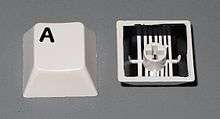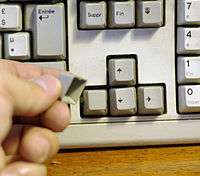Keycap


A keycap is a small plastic cover placed over the keyswitch of a computer keyboard. Keycaps are illustrated to indicate the key function or alphanumeric character they correspond to. Early keyboards were manufactured with the keyswitch and keycap integrated in one unit; separate keycaps were introduced to facilitate the production of different keyboard layouts.
Typical keycaps of the 1970s and 1980s were produced using two-shot molding, with the markings molded into each keycap in a different color of plastic, but this eventually fell out of favor, as it was more expensive (particularly in tooling costs), and tended to produce keycaps more durable than the equipment on which they were mounted. Modern keycaps are usually labelled by stamping or laser engraving.
Blank keycaps also exist. These promote touch typing and help build muscle memory because the user can’t "cheat" by looking down at the keyboard. A notable keyboard to use blank keycaps is the Das Keyboard "Ultimate" model; they are also used on the Filco Majestouch "Ninja."
The most common plastics used are ABS and PBT. ABS is cheap but is more prone to damage and deformation by chemicals and cleaning agents. PBT lasts longer and is more tolerant to chemicals and cleaning agents, but it costs more.
The top of a keycap may be described as cylinder-shaped (curving to the sides as if a fat cylinder was resting on it), flat or spherical (curving to the top, bottom and sides as if a large sphere was resting on it). The modern preference is for cylinder-shaped keycaps rather than spherical ones, but laptop keys are often flat.
Printing of numbers, letters, and symbols on the keycaps are done using pad printing, laser etching, or dye sublimation. Pad printing is the cheapest and most common. Dye sublimination is more expensive and only done by a few companies such as Topre, ZF Electronics, and Unicomp.
| Look up keycap in Wiktionary, the free dictionary. |
Further reading
- US Utility 5193924, Larson, Carlyn F., "Cap cover for keyboard keys", issued 16 March 1993